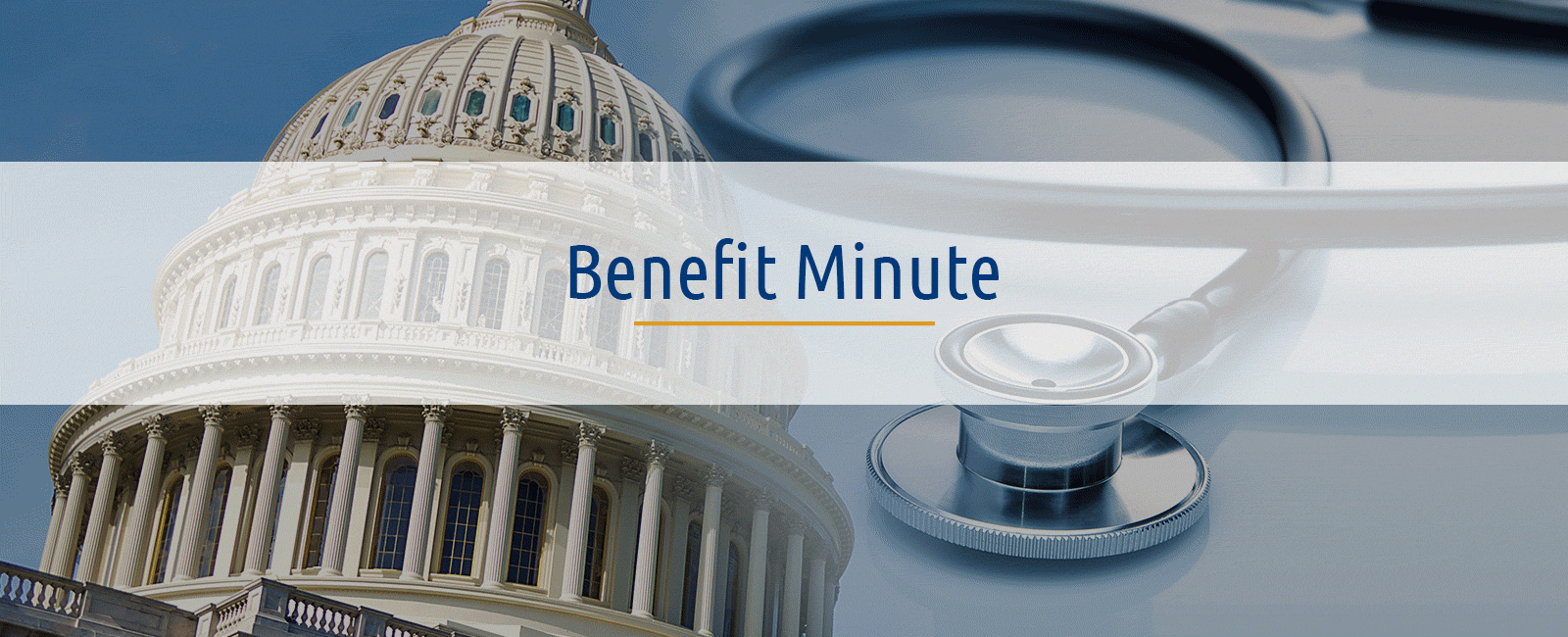First Quarter Compliance Updates (Benefit Minute)
Posted in: Benefit Minute, Employee Benefits
This issue provides a recap of some recent regulatory activity.
Telemedicine and Qualified High Deductible Health Plans (QHDHPs)
The CARES Act allowed an individual to remain eligible to contribute to a health savings account (HSA) if the individual had access to telemedicine services which were not subject to the QHDHP deductible. This applied for plan years that began before January 1, 2022. The recently passed spending bill reinstated this telemedicine relief for the period April 1, 2022 through December 31, 2022 (it is not retroactive and not based on plan year).
There is technically no relief until April 2022 for plan years that began in January, February or March 2022. However, the last month rule for HSA contributions would mitigate this.
Without additional legislation, this relief does not seem particularly helpful when telemedicine is embedded in the group health plan since:
- for 2022 plan years beginning before April 1, the plan should have been updated to require that the deductible apply (and would have to be amended to “undo” this)
- for plan years beginning on or after April 1, the relief does not extend for the full plan year
Updates on No Surprises Act
The No Surprises Act (NSA), which applies to plan years beginning on or after January 1, 2022, is intended to protect patients from unexpected balance billing in cases where they have little or no control over who provides their care. Instead, the NSA shifts responsibility for these expenses to providers and payers (insurers and self-insured health plans).
The qualifying payment amount (QPA) is an important concept in the NSA. The QPA is the median of the contracted rates recognized by the payer on January 31, 2019 for the same or similar item by a provider in the same or similar specialty and in the geographic region where the service is furnished, increased for inflation. It is the basis used to determine the cost-sharing amount that a participant must pay when a claim is subject to NSA. In addition, the regulation implementing the federal independent dispute resolution (IDR) process when payers and providers cannot agree on a payment amount states that the IDR entity (the arbiter in a payment dispute) must select the offer that is closest to the QPA unless credible information is submitted to demonstrate that the QPA is materially different from the appropriate out-of-network rate.
For the QPA calculation for items and services rendered in 2022, Revenue Procedure 2022-11 advised that the combined percentage increase to adjust the 2019 median contracted rate is 1.0648523983 (rounded to the nearest dollar). Further guidance was recently provided in IRS Notice 2022-11, which states that the combined percentage increase for calculating the QPA for an item or service furnished in 2022 for which a plan or issuer does not have sufficient information to calculate the median of the contracted rates in 2019 or when 2022 is the first coverage year for the item or service, the QPA should be calculated by multiplying the median of the in-network allowed amounts for the same or similar item or service provided in the geographic region in 2021, drawn from any eligible database, by the percentage increase of 1.0299772040.
The presumptive use of an amount closest to the QPA to resolve payment disputes between payers and providers as described above tends to favor payers. As a result, this regulation was challenged by a group of providers. The Court found in favor of the providers and vacated the language of regulations that gave deference to the QPA. Therefore, an IDR entity must equally weigh each of the factors set forth in the NSA when resolving claims for disputes involving payers and out-of-network providers or emergency facilities. In response, the agencies that issued the regulation have stated that they intend to withdraw guidance documents that are based on, or that refer to, the portions of the regulation that the Court invalidated and provide more training to IDR entities. This Court decision has no impact on the cost-sharing amount participants will be required to pay under the NSA. The federal IDR process applies when state law does not set the amount that must be paid to an out-of-network provider for a particular service. The NSA also defers to All-Payer model agreements and state laws that set reimbursement rates.
ACA Preventive Care Services
The ACA requires that non-grandfathered health plans cover certain preventive care services in-network with no cost-sharing. These services correspond with A and B recommendations of the U.S. Preventive Services Task Force, vaccine recommendations of the CDC’s Advisory Committee on Immunization Practices and guidelines for women’s and children’s preventive care services provided by the Health Resource and Services Administration (HRSA). As guidelines change over time, new or revised preventive care services generally must be covered for all plan years beginning one year after the date of the recommendation.
On December 30, 2021, the HRSA added or revised the following recommendations which must be covered for plan years beginning on or after January 1, 2023:
- New guideline for counseling to prevent obesity in women aged 40 to 60 years with normal or overweight BMI
- Updated guideline for double electric breast pumps, pump parts and maintenance, and breast milk storage supplies
- Updated guideline for full range of women’s contraceptives in the updated FDA Birth Control Guide
- Updated screening for HIV infection for all adolescent and adult women aged 15 and older at least once during their lifetime, and risk assessment and prevention education beginning at age 13
- Updated guideline for pre-pregnancy, prenatal, postpartum, and interpregnancy well-women visits
Transparency Machine Readable Files
As a reminder, under the Transparency in Coverage regulation issued in 2020, group health plans and health insurers must post online and update 2 separate machine readable files:
- In-network negotiated rates for covered items and services
- Allowed amounts paid to and charges billed by out-of-network providers for covered items and services
The deadline to post these files is July 1, 2022 for plan years beginning January 1 to July 1. Thereafter, the file must be published in the first month of the plan year.
Self-funded health plans may enter into a written contract with a TPA to have the TPA prepare and post these files, but the employer, through its group health plan, is still ultimately responsible for any violations. Employers with insured plans may contract in writing with the health insurance carrier to prepare and post the files, and the carrier will be responsible.



